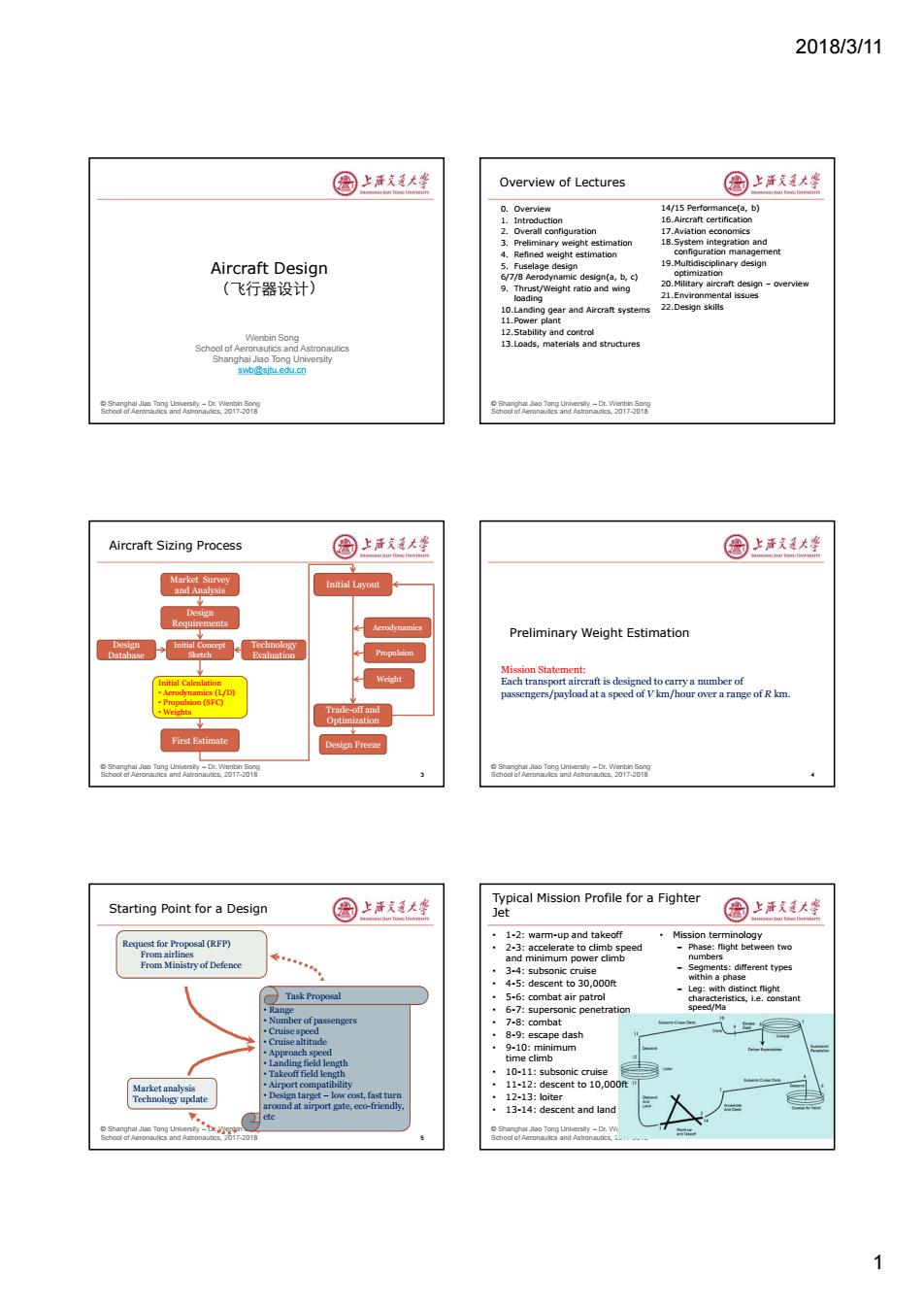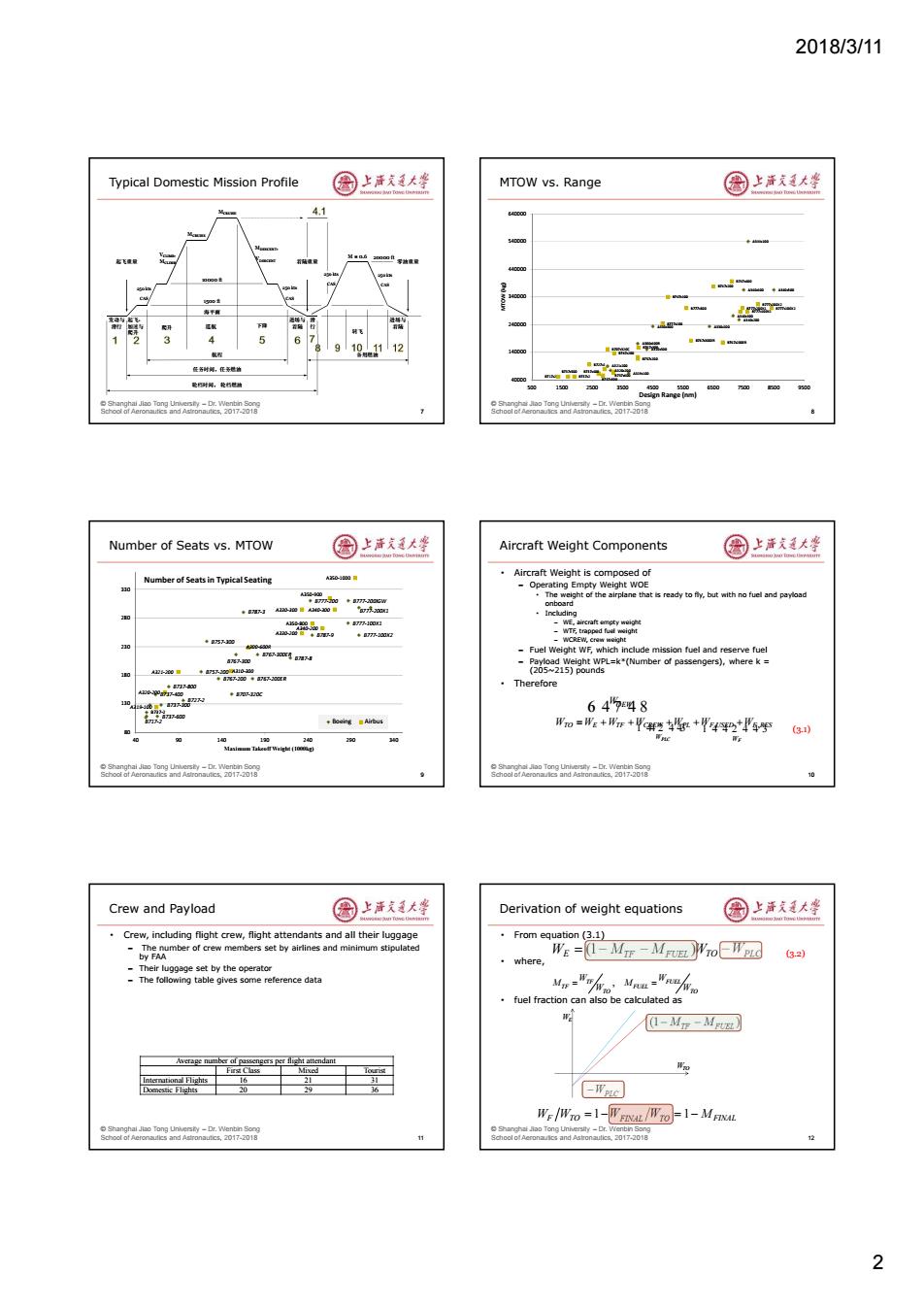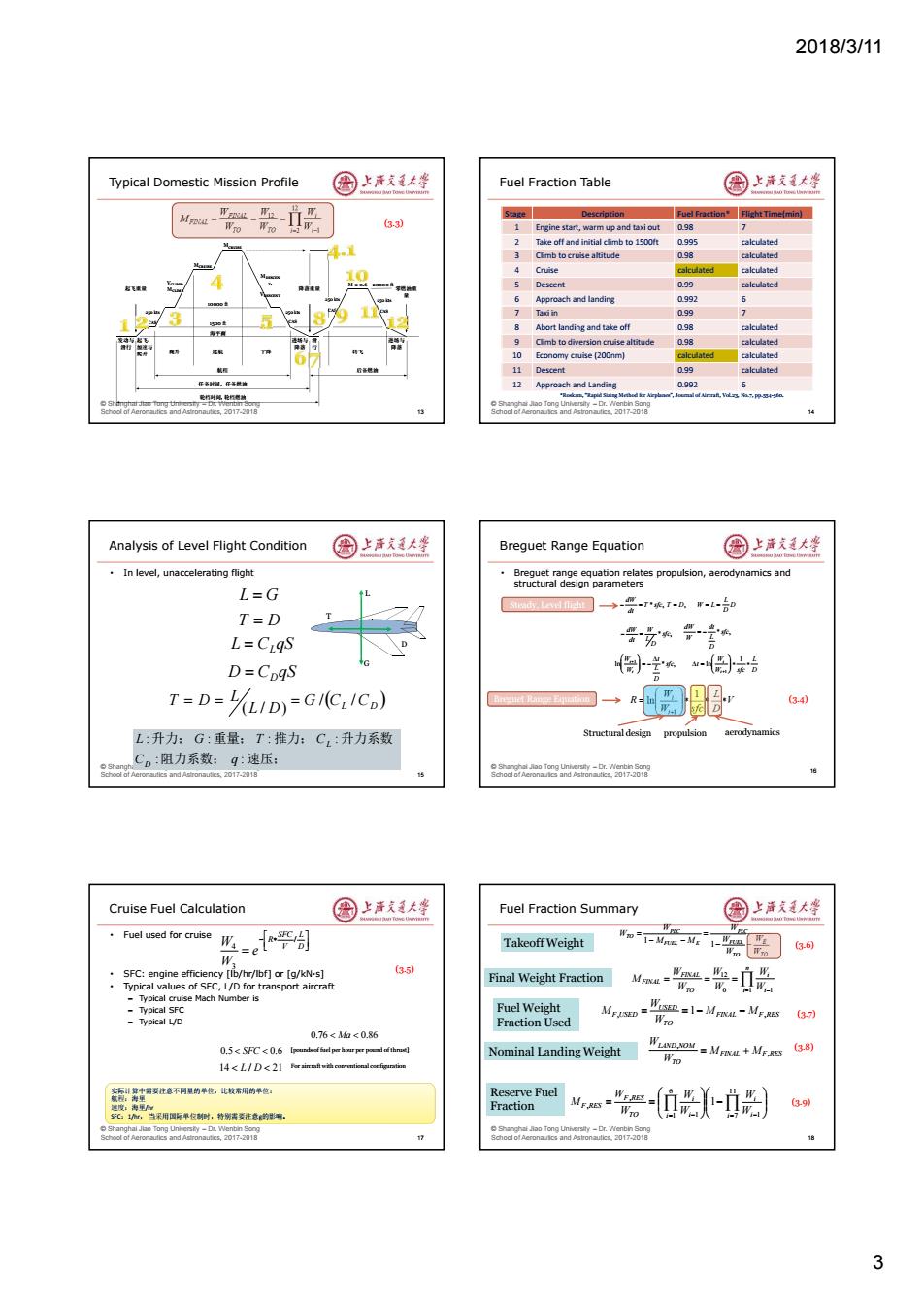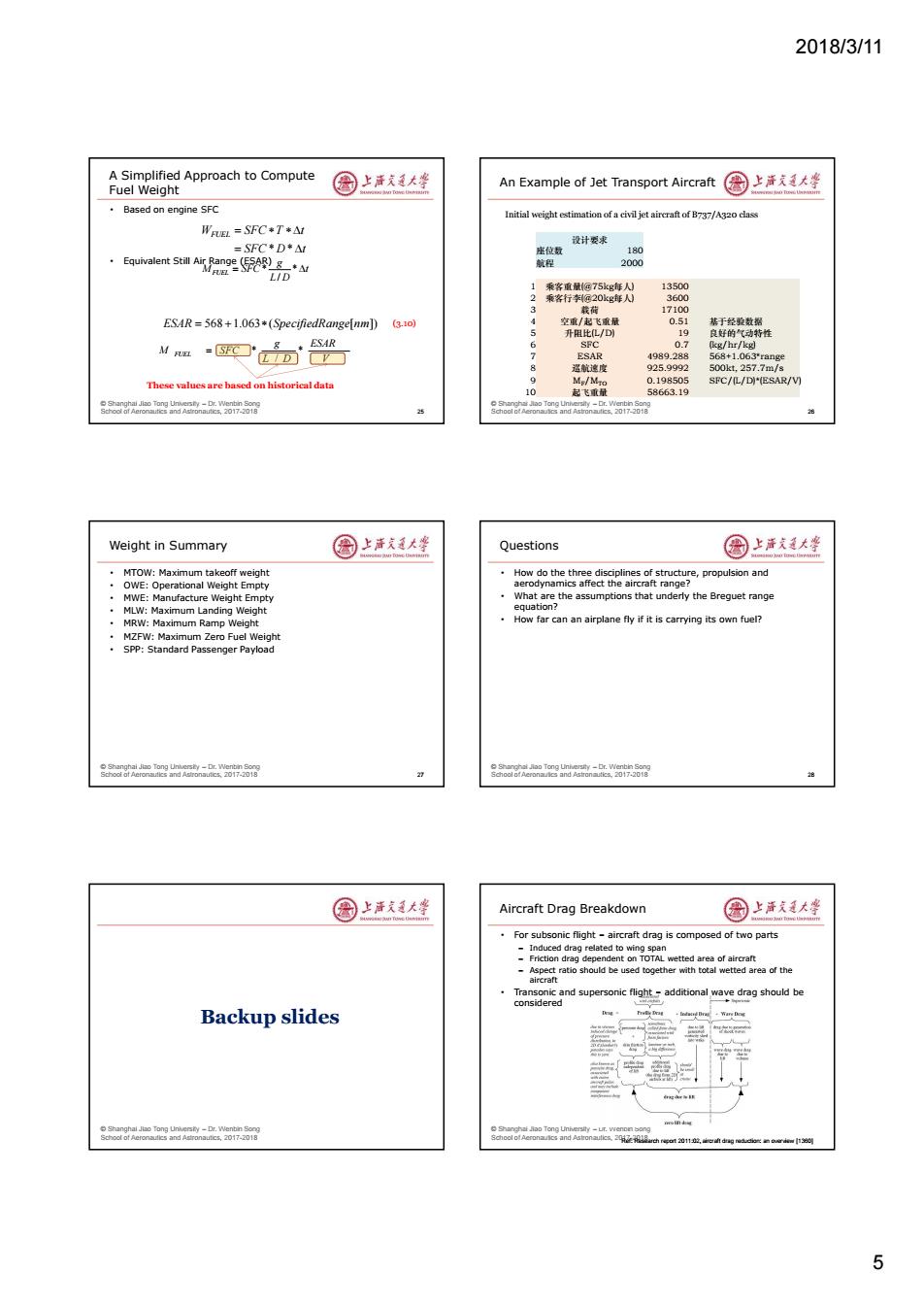
2018/3/11 圆上活大学 Overview of Lectures 国上清大学 0.Overview 14/15 Performance(a,b) 16.Aircraft certification 2.Overall configuration 17.Aviation economics 18.System integration and eight estimation configuration management Aircraft Design Fuselage design 19.Multidisciplinary design 6/7/8 Aerodynamic design(a,b,c) ootimization (飞行器设计) .hat and ing 20.Military aircraft design-overview 21.Environmental issues 10.Landing gear and Aircraft systems 22.Desian skills 11.Power plant Wenbin Song 12.Stability and control School of Aeronautics and Astronautics 13.Loads,materials and structures Shanghai Jiao Tong University swb@sjtu.edu.cn o r nd 0171 Aircraft Sizing Process (会上声文大警 国上道大坐 Market Survey Initial Layout Preliminary Weight Estimation Desg脚,nitial Concept Technology Database 1 Evaluation Mission Statement: Initial Calculation Each transport aircraft is designed to carry a number of passengers/payload at a speed of Vkm/hour over a range of R km. Trade-off and Optimization First Estimate esign Freeze 8oa6o0e四k-a88 Starting Point for a Design 国上清大学 Typical Mission Profile for a Fighter Jet 国上洋大学 1-2:warm-up and takeoff Mission terminology Request for Proposal (RFP) From airlines 2-3:accelerate to climb speed From Ministry of Defence and minimum power climb ·3-4:subsonic cruise nts:different types 4-5:descent to 30,000ft within a phase -Leo:with distinct flight Task Proposal 5-6:combat air patrol characteristics,i.e.constant ·Range 6-7:supersonic penetration speed/Ma Number of passengers ·7-8:combat Cruisespeed 8-9:escape dash ·Cruise altitude ·Approach speed ·9-10:minimum ·anding field length time climb ·Takeoff field length 10-11:subsonic cruise Market analysis 'Airport compatibility .11-12:descent to 10.000ft Technology update Design target-low cost,fast turn ·12-13:loiter around at airport gate,eco-friendly. ete 13-14:descent and land sity -Dr.W 1
2018/3/11 1 © Shanghai Jiao Tong University – Dr. Wenbin Song School of Aeronautics and Astronautics, 2017-2018 Wenbin Song School of Aeronautics and Astronautics Shanghai Jiao Tong University swb@sjtu.edu.cn Aircraft Design (飞行器设计) © Shanghai Jiao Tong University – Dr. Wenbin Song School of Aeronautics and Astronautics, 2017-2018 Overview of Lectures 0. Overview 1. Introduction 2. Overall configuration 3. Preliminary weight estimation 4. Refined weight estimation 5. Fuselage design 6/7/8 Aerodynamic design(a, b, c) 9. Thrust/Weight ratio and wing loading 10.Landing gear and Aircraft systems 11.Power plant 12.Stability and control 13.Loads, materials and structures 14/15 Performance(a, b) 16.Aircraft certification 17.Aviation economics 18.System integration and configuration management 19.Multidisciplinary design optimization 20.Military aircraft design – overview 21.Environmental issues 22.Design skills © Shanghai Jiao Tong University – Dr. Wenbin Song School of Aeronautics and Astronautics, 2017-2018 Aircraft Sizing Process 3 Market Survey and Analysis Design Requirements Design Database Initial Concept Sketch Technology Evaluation Initial Calculation • Aerodynamics (L/D) • Propulsion (SFC) • Weights First Estimate Initial Layout Aerodynamics Propulsion Weight Trade-off and Optimization Design Freeze © Shanghai Jiao Tong University – Dr. Wenbin Song School of Aeronautics and Astronautics, 2017-2018 Preliminary Weight Estimation 4 Mission Statement: Each transport aircraft is designed to carry a number of passengers/payload at a speed of V km/hour over a range of R km. © Shanghai Jiao Tong University – Dr. Wenbin Song School of Aeronautics and Astronautics, 2017-2018 Starting Point for a Design 5 Request for Proposal (RFP) From airlines From Ministry of Defence • Range • Number of passengers • Cruise speed • Cruise altitude • Approach speed • Landing field length • Takeoff field length • Airport compatibility • Design target – low cost, fast turn around at airport gate, eco-friendly, etc Task Proposal Market analysis Technology update © Shanghai Jiao Tong University – Dr. Wenbin Song School of Aeronautics and Astronautics, 2017-2018 Typical Mission Profile for a Fighter Jet • 1-2: warm-up and takeoff • 2-3: accelerate to climb speed and minimum power climb • 3-4: subsonic cruise • 4-5: descent to 30,000ft • 5-6: combat air patrol • 6-7: supersonic penetration • 7-8: combat • 8-9: escape dash • 9-10: minimum time climb • 10-11: subsonic cruise • 11-12: descent to 10,000ft • 12-13: loiter • 13-14: descent and land • Mission terminology – Phase: flight between two numbers – Segments: different types within a phase – Leg: with distinct flight characteristics, i.e. constant speed/Ma

2018/3/11 Typical Domestic Mission Profile 圆上活发美大坐 MTOW vs.Range 国上清大学 4.1 540000 飞便量 1 3 4 101112 400 Number of Seats vs.MTOW 国上清文大些 Aircraft Weight Components 圈上活大整 Number of Seats in TypicalSeating AZ0-3009 Aircraft Weight is composed of 10 -Operating Empty Weight WOE ow The weight of the airplane that is ready to fly,but with no fuel and payload 器 ◆m-g ◆Pa号 Fuel Weight WF,which include mission fuel and reserve fuel 0】·Bn 00 。Therefore ◆50-0c 10, 6448 Wo=用+形r+W群变4+甲4段* 40 20 8oa6o0e四k-a88 Crew and Payload 国上洋大坐 Derivation of weight equations 园上海发大坐 Crew,including flight crew,flight attendants and all their luggage ·From equation(3.1) umber of crew members set by airlines and minimum stipulated WE=-Mr-MaWo'p园 32) ·where, M-hnMna-uho fuel fraction can also be cakculated as (1-MI-MrUB) Flights Domestic Flights -WPIC WE/WTo =1-WEINAL /WTo=1-MFINAL 2
2018/3/11 2 © Shanghai Jiao Tong University – Dr. Wenbin Song School of Aeronautics and Astronautics, 2017-2018 Typical Domestic Mission Profile 7 250 kts CAS 发动与 滑行 起飞、 加速与 爬升 爬升 巡航 下降 进场与 着陆 滑 行 进场与 着陆 转飞 航程 任务时间,任务燃油 轮档时间, 轮档燃油 备用燃油 起飞重量 着陆重量 零油重量 10000 ft 1500 ft 海平面 20000 ft 250 kts CAS 250 kts CAS VCLIMB, MCLIMB MCRUISE MCRUISE MDESCENT, VDESCENT M = 0.6 250 kts CAS © Shanghai Jiao Tong University – Dr. Wenbin Song School of Aeronautics and Astronautics, 2017-2018 MTOW vs. Range 8 A300-600R A310-300 A319-100 A320-200 A321-200 A330-300 A330-200 A340-200 A340-300 A340-600 A340-500 A3XX-100 B707-320C B717-2 B727-2 B737-2 B737-300 B737-500 B737-400 B737-600 B747-100 B747-200 B747-400 B757-200 B767-200 B767-200ER B767-300 B767-300ER B777-100X1 B777-100X2 B777-200 B777-200X1B777-200X2 B777-300 40000 140000 240000 340000 440000 540000 640000 500 1500 2500 3500 4500 5500 6500 7500 8500 9500 MTOW (kg) Design Range (nm) © Shanghai Jiao Tong University – Dr. Wenbin Song School of Aeronautics and Astronautics, 2017-2018 Number of Seats vs. MTOW 9 B707-320C B717-2 B727-2 B737-2 B737-300 B737-400 B737-600 B737-800 B757-200 B757-300 B767-200 B767-200ER B767-300 B767-300ER B777-100X1 B777-100X2 B777-200 B777-200IGW B787-3 B777-200X1 B787-8 B787-9 A300-600R A310-300 A319-100 A320-200 A321-200 A330-200 A330-300A340-200 A340-300 A350-800 A350-900 A350-1000 80 130 180 230 280 330 40 90 140 190 240 290 340 Maximum Takeoff Weight (1000kg) Number of Seats in Typical Seating Boeing Airbus © Shanghai Jiao Tong University – Dr. Wenbin Song School of Aeronautics and Astronautics, 2017-2018 Aircraft Weight Components • Aircraft Weight is composed of – Operating Empty Weight WOE • The weight of the airplane that is ready to fly, but with no fuel and payload onboard • Including – WE, aircraft empty weight – WTF, trapped fuel weight – WCREW, crew weight – Fuel Weight WF, which include mission fuel and reserve fuel – Payload Weight WPL=k*(Number of passengers), where k = (205~215) pounds • Therefore 10 PLC WF F USED F RES W WTO WE WTF WCREW WPL W , W , WOEW (3.1) © Shanghai Jiao Tong University – Dr. Wenbin Song School of Aeronautics and Astronautics, 2017-2018 Crew and Payload • Crew, including flight crew, flight attendants and all their luggage – The number of crew members set by airlines and minimum stipulated by FAA – Their luggage set by the operator – The following table gives some reference data 11 Average number of passengers per flight attendant First Class Mixed Tourist International Flights 16 21 31 Domestic Flights 20 29 36 © Shanghai Jiao Tong University – Dr. Wenbin Song School of Aeronautics and Astronautics, 2017-2018 Derivation of weight equations • From equation (3.1) • where, • fuel fraction can also be calculated as 12 WE MTF MFUEL WTO WPLC (1 ) TO FUEL FUEL TO TF TF W W M W W M , (3.2) WPLC (1 ) MTF MFUEL WE WTO WF WTO WFINAL WTO MFINAL 1 1

2018/3/11 Typical Domestic Mission Profile 园上声文大学 Fuel Fraction Table 国上洋文大坐 Stage Description Fuel Fraction Flight Timefmin) 3.3 1 Engine start,warm up and taxi out 0.98 7 2 Take off and initial climb to 1500ft 0.995 calculated 4.1 3 Climb to cruise altitude 098 calculated Cruise calculated 4 5 Descent 0.99 calculated 6 Approach and landing Q992 6 7 Taxi in 0.99 7 8 Abort landing and take off 0.98 calculated Climb to diversion cruise altitude Q.98 10 Economy cruise(200nm) calculated calculated 后 11 Descent 0.99 calculated 12 Approach and Landing Q992 影竹时%轮打测动 2017-2018 Analysis of Level Flight Condition 国上活文道大堂 Breguet Range Equation 国上清支大峰 In level,unaccelerating flight Breguet range equation relates propulsion,aerodynamics and structural design parameters L=G →号ga0 T=D L=CLqS 鲁完% D=CDqS 管。*台 T=D=HLID)=GIC:ICo) 回→花分r (3.4) L:升力:G:重量:T:推力:C,:升力系数 Structuraldesign propulsion C。阻力系数:q:速压: ero androna1 8oa6o0e四k-a88 Cruise Fuel Calculation 图上洋大峰 Fuel Fraction Summary 图上活大坐 1 ·Fuel used for cruise W Takeoff Weight 3.6 W SFC:engine efficiency [ib/hr/Ibf]or [/kN.s] (35 Final Weight Fraction Typical values of SFC,L/D for transport aircraft m陪-晓 -Typical cruise Mach Number is Typical SFC Fuel Weight MrsM -Typical L/D Fraction Used WTO 37》 0.76<Ma<0.86 0.5<SFC<0.6 Nominal Landing Weight (38) 14<L/D<21 额中苦要注意不円量的单包,比较常用的单包。 Reserve Fuel Fraction “器-二-品) 39 3
2018/3/11 3 © Shanghai Jiao Tong University – Dr. Wenbin Song School of Aeronautics and Astronautics, 2017-2018 Typical Domestic Mission Profile 13 12 2 1 12 i i i TO TO FINAL FINAL W W W W W W M (3.3) 250 kts CAS 发动与 滑行 起飞、 加速与 爬升 爬升 巡航 下降 进场与 降落 滑 行 进场与 降落 转飞 航程 任务时间,任务燃油 轮档时间, 轮档燃油 后备燃油 起飞重量 降落重量 零燃油重 量 10000 ft 1500 ft 海平面 20000 ft 250 kts CAS 250 kts CAS VCLIMB, MCLIMB MCRUISE MCRUISE MDESCEN T , VDESCENT M = 0.6 250 kts CAS © Shanghai Jiao Tong University – Dr. Wenbin Song School of Aeronautics and Astronautics, 2017-2018 Fuel Fraction Table 14 Stage Description Fuel Fraction* Flight Time(min) 1 Engine start, warm up and taxi out 0.98 7 2 Take off and initial climb to 1500ft 0.995 calculated 3 Climb to cruise altitude 0.98 calculated 4 Cruise calculated calculated 5 Descent 0.99 calculated 6 Approach and landing 0.992 6 7 Taxi in 0.99 7 8 Abort landing and take off 0.98 calculated 9 Climb to diversion cruise altitude 0.98 calculated 10 Economy cruise (200nm) calculated calculated 11 Descent 0.99 calculated 12 Approach and Landing 0.992 6 *Roskam, “Rapid Sizing Method for Airplanes”, Journal of Aircraft, Vol.23, No.7, pp.554-560. © Shanghai Jiao Tong University – Dr. Wenbin Song School of Aeronautics and Astronautics, 2017-2018 Analysis of Level Flight Condition • In level, unaccelerating flight 15 L G T D L CLqS D C qS D L D G CL CD T D L / / ( / ) 阻力系数; 速压; 升力; 重量; 推力; 升力系数 : : : : : : C q L G T C D L LG T D © Shanghai Jiao Tong University – Dr. Wenbin Song School of Aeronautics and Astronautics, 2017-2018 Breguet Range Equation • Breguet range equation relates propulsion, aerodynamics and structural design parameters 16 Steady, Level flight T * sfc, T D, dt dW D D L W L * sfc, D L W dt dW * sfc, D L dt W dW ln * , 1 sfc D L t W W i i D L W sfc W t i i 1 ln 1 V D L W sfc W R i i 1 ln 1 Breguet Range Equation Structural design propulsion aerodynamics (3.4) © Shanghai Jiao Tong University – Dr. Wenbin Song School of Aeronautics and Astronautics, 2017-2018 Cruise Fuel Calculation • Fuel used for cruise • SFC: engine efficiency [lb/hr/lbf] or [g/kN∙s] • Typical values of SFC, L/D for transport aircraft – Typical cruise Mach Number is – Typical SFC – Typical L/D 17 / 4 3 SFC L R W V D e W 0.76 Ma 0.86 0.5 SFC 0.6 14 / 21 L D [pounds of fuel per hour per pound of thrust] (3.5) 实际计算中需要注意不同量的单位,比较常用的单位: 航程:海里 速度:海里/hr SFC:1/hr, 当采用国际单位制时,特别需要注意g的影响。 For aircraft with conventional configuration © Shanghai Jiao Tong University – Dr. Wenbin Song School of Aeronautics and Astronautics, 2017-2018 Fuel Fraction Summary 18 Final Weight Fraction Fuel Weight Fraction Used Nominal Landing Weight Reserve Fuel Fraction n i i i TO FINAL FINAL W W W W W W M 0 1 1 12 Takeoff Weight TO E TO FUEL PLC FUEL E PLC TO W W W W W M M W W 1 1 FINAL F RES TO USED F USED M M W W M , 1 , FINAL F RES TO LAND NOM M M W W , , 11 7 1 6 1 1 , , 1 i i i i i i TO F RES F RES W W W W W W M (3.6) (3.7) (3.8) (3.9)

2018/3/11 Historical Trend Line for WE 国上活大坐 Trapped Fuel 国上清大学 What we know:historical data from similar aircrafts can be used Trapped fuel is typically small,as percentage of aircraft take off What we also know:the new aircraft should be better weight And can be estimated using Can als be 3.1) Mre =0227MLWTo Soor an0 the First Weight Estimate 圆上清文大些 Estimation of SFC 国上道大坐 Mission SFC:is the fuel mass required to provide specific net thrust for a requirement given period,[lb/hr/Ibf]or [g/(kN-s)] Typical values for SFC Concept Sketeh Initial Sizing Aspect Ratio L/D TypicalJet SFCs:1/hr(mg/Ns]Cruise Loiter Estimates ww。 Pure turbojet 0.92551 0.822.71 selection Low-bypass turbofan 0.822.7刀 0.719.8 High-bypass turbofan 05f141 0.411.3到 ww。 equation iterate Wa -1-Mrm-Me1 Calculated w。and (.6) 8oa6o0e四k-a88 Estimation of L/D 图上洋大峰 Weight Estimation Iteration 园上海发大坐 Reflects the overall aerodynamic efficiency At subsonic speed,mostly affected Wing span -Wetted area In level flight,L=G,L/D depends on D Drag is composed of -Induced drag,caused by the generation of lift -Zero-lift drag,primarily skin-friction drag and directly related to the total exposed surface area of the aircraft Historical data of similar aircraft are often used -- -初时” 4
2018/3/11 4 © Shanghai Jiao Tong University – Dr. Wenbin Song School of Aeronautics and Astronautics, 2017-2018 Historical Trend Line for WE • What we know: historical data from similar aircrafts can be used • What we also know: the new aircraft should be better 19 B707-320C B717-200B727-200Adv B737-200 B737-300 B737-400 B737-500 B737-600 B737-700 B737-800 B747-100B747-200 B747-400 B757-200 B757-300 B767-200B767-200ER B767-300 B767-300ER B777-200B777-200IGW B777-300 A300-600R A310-300 A319-100 A320-200 A321-200 A330-300 A330-200 A340-200 A340-300 A340-500 A340-600 A3XX-100 0.4 50000.4 100000.4 150000.4 200000.4 250000.4 300000.4 0 100000 200000 300000 400000 500000 600000 Operating Empty Weight (kg) Maximum Takeoff Weight (kg) 0.079 1000 0.82 MTOW MTOW OE W W W MTOW MTOW OE W W W 0.5* © Shanghai Jiao Tong University – Dr. Wenbin Song School of Aeronautics and Astronautics, 2017-2018 Trapped Fuel • Trapped fuel is typically small, as percentage of aircraft take off weight • And can be estimated using • Can also be ignored at this stage 20 0.001 MTF 0.005 2 / 3 1/ 3 0.227 MTF MFUELWTO (3.11) © Shanghai Jiao Tong University – Dr. Wenbin Song School of Aeronautics and Astronautics, 2017-2018 the First Weight Estimate 21 Mission requirement Concept Sketch Initial Sizing Swet/Sref Aspect Ratio Estimates L/D SFC We /W0 Wf/W0 W0 guess W0 equation Calculated W0 and Wf Engine selection iterate Equation (3.6) TO E TO FUEL PLC FUEL E PLC TO W W W W W M M W W 1 1 © Shanghai Jiao Tong University – Dr. Wenbin Song School of Aeronautics and Astronautics, 2017-2018 Estimation of SFC • SFC: is the fuel mass required to provide specific net thrust for a given period, [lb/hr/lbf] or [g/(kN∙s)] • Typical values for SFC • 22 Typical Jet SFCs: 1/hr[mg/Ns] Cruise Loiter Pure turbojet 0.9[25.5] 0.8[22.7] Low-bypass turbofan 0.8[22.7] 0.7[19.8] High-bypass turbofan 0.5[14.1] 0.4[11.3] © Shanghai Jiao Tong University – Dr. Wenbin Song School of Aeronautics and Astronautics, 2017-2018 Estimation of L/D • Reflects the overall aerodynamic efficiency • At subsonic speed, mostly affected – Wing span – Wetted area • In level flight, L=G, L/D depends on D • Drag is composed of – Induced drag, caused by the generation of lift – Zero-lift drag, primarily skin-friction drag and directly related to the total exposed surface area of the aircraft • Historical data of similar aircraft are often used 23 © Shanghai Jiao Tong University – Dr. Wenbin Song School of Aeronautics and Astronautics, 2017-2018 Weight Estimation Iteration 24

2018/3/11 A Simplified Approach to Compute Fuel Weight 圈上声天大学 An Example of Jet Transport Aircraft 周上洋文大学 ·Based on engine SFC Initial weight estimation of a civiljet aircraft of B737/A320 class WuE=SFC◆T*M ·a9258品N =SFC*D*△M 设计要求 座位数 180 航程 2000 乘客重量@75kg每人小 13500 乘客行李料@ 20kg每人J 3600 17100 ESAR=568+1.063*(SpecifiedRange[nml)(310) 空重/起飞重量 0.5 基于经验数据 升阻比L/D) 19 良好的气动特性 Mm='D万 ESAR 6 SFC 07 (kg/hr/kg) ESAR 4989.288 568+1.063 range 8 巡航速度 925.9992 500kt,257.7m/s These values are based on historical data ME/Mre 0.198505 SFC/(L/D)(ESAR/V) 起飞重量 58663.19 o r nd 0171 Weight in Summary 国上活美大坐 Questions 国上活支大峰 MTOW:Maximum takeoff weight How do the three disciplines of structure,propulsion and OWE:Operational Weight Empty aerodynamics affect the aircraft range? MWE:Manufacture Weight Empty What are the assumptions that underly the Breguet range MLW:Maximum Landing Weight equation? MRW:Maximum Ramp Weight How far can an airplane fly if it is carrying its own fuel? MZFW:Maximum Zero Fuel Weight SPP:Standard Passenger Payload rAer 8oa6o0e四k-a88 国上清大学 Aircraft Drag Breakdown 国上清大学 For subsonic flight-aircraft drag is composed of two parts Induced drag related to wing span Friction drag dependent on TOTAL wetted area of aircraft -Aspect ratio should be used together with total wetted area of the aircraft Transonic and supersonic flight additional wave drag should be considered Backup slides tngde sity-ut.vrenon Schoot ot Nerona and Paton 5
2018/3/11 5 © Shanghai Jiao Tong University – Dr. Wenbin Song School of Aeronautics and Astronautics, 2017-2018 A Simplified Approach to Compute Fuel Weight • Based on engine SFC • Equivalent Still Air Range (ESAR) 25 SFC D t W SFC T t FUEL * * ESAR 568 1.063(SpecifiedRange[nm]) t L D g MFUEL SFC * / * V ESAR L D g M FUEL SFC * / * These values are based on historical data (3.10) © Shanghai Jiao Tong University – Dr. Wenbin Song School of Aeronautics and Astronautics, 2017-2018 An Example of Jet Transport Aircraft 26 设计要求 座位数 180 航程 2000 1 乘客重量(@75kg每人) 13500 2 乘客行李(@20kg每人) 3600 3 载荷 17100 4 空重/起飞重量 0.51 基于经验数据 5 升阻比(L/D) 19 良好的气动特性 6 SFC 0.7 (kg/hr/kg) 7 ESAR 4989.288 568+1.063*range 8 巡航速度 925.9992 500kt, 257.7m/s 9 MF /MTO 0.198505 SFC/(L/D)*(ESAR/V) 10 起飞重量 58663.19 Initial weight estimation of a civil jet aircraft of B737/A320 class © Shanghai Jiao Tong University – Dr. Wenbin Song School of Aeronautics and Astronautics, 2017-2018 Weight in Summary • MTOW: Maximum takeoff weight • OWE: Operational Weight Empty • MWE: Manufacture Weight Empty • MLW: Maximum Landing Weight • MRW: Maximum Ramp Weight • MZFW: Maximum Zero Fuel Weight • SPP: Standard Passenger Payload 27 © Shanghai Jiao Tong University – Dr. Wenbin Song School of Aeronautics and Astronautics, 2017-2018 Questions • How do the three disciplines of structure, propulsion and aerodynamics affect the aircraft range? • What are the assumptions that underly the Breguet range equation? • How far can an airplane fly if it is carrying its own fuel? 28 © Shanghai Jiao Tong University – Dr. Wenbin Song School of Aeronautics and Astronautics, 2017-2018 Backup slides © Shanghai Jiao Tong University – Dr. Wenbin Song School of Aeronautics and Astronautics, 2017-2018 Aircraft Drag Breakdown • For subsonic flight – aircraft drag is composed of two parts – Induced drag related to wing span – Friction drag dependent on TOTAL wetted area of aircraft – Aspect ratio should be used together with total wetted area of the aircraft • Transonic and supersonic flight – additional wave drag should be considered Ref: Research report 2011:02, aircraft drag reduction: an overview [1360]

2018/3/11 How Aspect Ratio Relates to Wing Drag 圈上声文大学 Quick Estimation of Cp 国上洋文大坐 Aerodynamic efficiency of wing-only configuration depicted by the relations between L/D Aspect Ratio Valid in comparisons between the same configuration osdra due to lift (skin friction and pressure Fuselage or configuration is the additional factor to consider ·Or in another form Oswald factor is a better parameter used to calculate the draa Cp K C K2CL Cop where,="K=-2K",and Coo=Comim+K"Cmm (drag at zero lift) r n 7 Soor an0 6
2018/3/11 6 © Shanghai Jiao Tong University – Dr. Wenbin Song School of Aeronautics and Astronautics, 2017-2018 How Aspect Ratio Relates to Wing Drag • Aerodynamic efficiency of wing-only configuration depicted by the relations between • L/D ~ Aspect Ratio • Valid in comparisons between the same configuration • Fuselage or configuration is the additional factor to consider • Oswald factor is a better parameter used to calculate the drag © Shanghai Jiao Tong University – Dr. Wenbin Song School of Aeronautics and Astronautics, 2017-2018 Quick Estimation of 𝑪𝑫 • Conventional form of the lift-drag-polar equation can be given as 𝐶 = 𝐶 + 𝐾ᇱ𝐶ଶ + 𝐾ᇱᇱ 𝐶 − 𝐶 ଶ • where 𝐾 ᇱ is the inviscid drag due to lift and 𝐾 ᇱᇱ is the viscous drag due to lift (skin friction and pressure drag). • Or in another form 𝐶 = 𝐾ଵ𝐶ଶ + 𝐾ଶ𝐶 + 𝐶 • where, 𝐾ଵ = 𝐾ᇱ + 𝐾ᇱᇱ, 𝐾ଶ = −2𝐾ᇱᇱ𝐶, and 𝐶 = 𝐶 + 𝐾ᇱᇱ𝐶 ଶ (drag at zero lift)